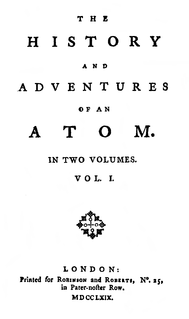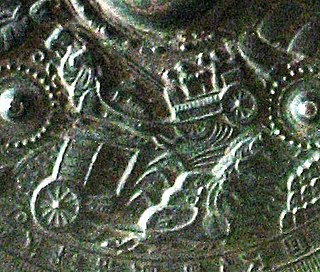
A tribute is wealth, often in kind, that a party gives to another as a sign of submission, allegiance or respect. Various ancient states exacted tribute from the rulers of land which the state conquered or otherwise threatened to conquer. In case of alliances, lesser parties may pay tribute to more powerful parties as a sign of allegiance and often in order to finance projects that would benefit both parties. To be called "tribute" a recognition by the payer of political submission to the payee is normally required; the large sums, essentially protection money, paid by the later Roman and Byzantine Empires to barbarian peoples to prevent them attacking imperial territory, would not usually be termed "tribute" as the Empire accepted no inferior political position. Payments by a superior political entity to an inferior one, made for various purposes, are described by terms including "subsidy".

Perilla frutescensvar.crispa, also known by its Japanese name shiso, is a cultigen of Perilla frutescens, a herb in the mint family Lamiaceae. It is native to the mountainous regions of China and India, but is now found worldwide. The plant occurs in several forms, as defined by the characteristics of their leaves, including red, green, bicolor, and ruffled. Shiso is perennial and may be cultivated as an annual in temperate climates. Different parts of the plant are used in East Asian and Southeast Asian cuisine.

Cloisonné is an ancient technique for decorating metalwork objects with colored material held in place or separated by metal strips or wire, normally of gold. In recent centuries, vitreous enamel has been used, but inlays of cut gemstones, glass and other materials were also used during older periods; indeed cloisonné enamel very probably began as an easier imitation of cloisonné work using gems. The resulting objects can also be called cloisonné. The decoration is formed by first adding compartments to the metal object by soldering or affixing silver or gold as wires or thin strips placed on their edges. These remain visible in the finished piece, separating the different compartments of the enamel or inlays, which are often of several colors. Cloisonné enamel objects are worked on with enamel powder made into a paste, which then needs to be fired in a kiln. If gemstones or colored glass are used, the pieces need to be cut or ground into the shape of each cloison.
Unequal treaty is the name given by the Chinese to a series of treaties signed between China and various Western powers, the Russian Empire, and the Empire of Japan during the 19th and early 20th centuries. The agreements, often reached after a military defeat, contained one-sided terms requiring China to cede land, pay reparations, open treaty ports, or grant extraterritorial privileges to foreign citizens.

An urn is a vase, often with a cover, with a typically narrowed neck above a rounded body and a footed pedestal. Describing a vessel as an "urn", as opposed to a vase or other terms, generally reflects its use rather than any particular shape or origin. The term is especially often used for funerary urns, vessels used in burials, either to hold the cremated ashes or as grave goods, but is used in many other contexts; in catering large vessels for serving tea or coffee are often called "tea-urns", even when they are metal cylinders of purely functional design. Large sculpted vases are often called urns, whether placed outdoors, in gardens or as architectural ornaments on buildings, or kept inside. Urns are also a common reference in thought experiments in probability wherein marbles or balls of different colors are used to represent different results and the urn represents the "container" of the whole set of possible states.
The word Japan is an exonym, and is used by many languages. The Japanese names for Japan are Nippon and Nihon. They are both written in Japanese using the kanji 日本.

The Japan–Korea Treaty of 1876 was made between representatives of the Empire of Japan and the Korean Kingdom of Joseon in 1876. Negotiations were concluded on February 26, 1876.
The politics of the Joseon dynasty, which ruled Korea from 1392 to 1897, were governed by the reigning ideology of Korean Confucianism, a form of Neo-Confucianism. Political struggles were common between different factions of the scholar-officials. Purges frequently resulted in leading political figures being sent into exile or condemned to death.

The History and Adventures of an Atom is a novel by Tobias Smollett, first published in 1769. The novel savagely satirises English politics during the Seven Years' War.

Surprise Lake Camp is a non-profit sleepaway camp located on over 400 acres (1.6 km2) in Cold Spring, New York. It is one of the oldest Jewish summer camps in the United States.

The Museum of Anthropology, University of Athens is an educational museum in Athens, Greece. It was founded at the University of Athens in 1886.
Ishin-denshin (以心伝心) is an idiom commonly used in East Asian cultures such as Japan, Korea, China, which denotes a form of interpersonal communication through unspoken mutual understanding. This four-character compound's kanji literally translates as "like minds, (are) communicating minds". Sometimes translated into English as "telepathy" or "sympathy", ishin-denshin is also commonly rendered as "heart-to-heart communication" or "tacit understanding".

East Asia is the eastern region of Asia, which is defined in both geographical and ethno-cultural terms. The modern states of East Asia include China, Japan, Mongolia, North Korea, South Korea, and Taiwan. China, North Korea, South Korea and Taiwan are all unrecognised by at least one other East Asian state due to severe ongoing political tensions in the region, specifically the division of Korea and the political status of Taiwan. Hong Kong and Macau, two small coastal quasi-dependent territories located in the south of China, are officially highly autonomous but are under de jure Chinese sovereignty. East Asia borders Siberia and the Russian Far East to the north, Southeast Asia to the south, South Asia to the southwest, and Central Asia to the west. To the east is the Pacific Ocean and to the southeast is Micronesia.

Horses in East Asian warfare are inextricably linked with the strategic and tactical evolution of armed conflict. A warrior on horseback or horse-drawn chariot changed the balance of power between civilizations.
Imperial Chinese missions to the Ryukyu Kingdom were diplomatic missions which were intermittently sent by the Yuan, Ming and Qing emperors to Shuri, Okinawa in the Ryukyu Islands. These diplomatic contacts were within the Sinocentric system of bilateral and multinational relationships in East Asia.
Beach Chair is a short computer animation test clip created by animator Eben Ostby for Pixar in 1986. It depicts a chair walking across the sand, dipping its leg into the water, and then moving along. Ostby made the project with the feedback of John Lasseter to work out details of rendering software.

Genbō was a Japanese scholar-monk and bureaucrat of the Imperial Court at Nara. He is best known as a leader of the Hossō sect of Buddhism and as the adversary of Fujiwara no Hirotsugu.

A rice burger or riceburger is a variation on the traditional hamburger with compressed rice patties substituted for the hamburger buns. The MOS Burger fast-food restaurant chain introduced the rice burger in Japan 1987, and since then it has become a popular food item in East Asia. Beginning around 2005 McDonald's also offered a rice burger in some of its Asian stores, with mixed results. In South Korea they are known as "bapburgers". Popular Korean-style rice burgers include fillings such as Stir-fried kimchi and tuna with mayonnaise.
Flags and Waves is a short computer animation test clip which was created by animator Bill Reeves and Alain Fournier for Pixar sometime in 1986. The clip included waves reflecting a sunset and lapping against the shore. Reeves and Fournier made the project with the feedback of John Lasseter to work out details of rendering water and waves realistically, including lighting, motion, and shading.












